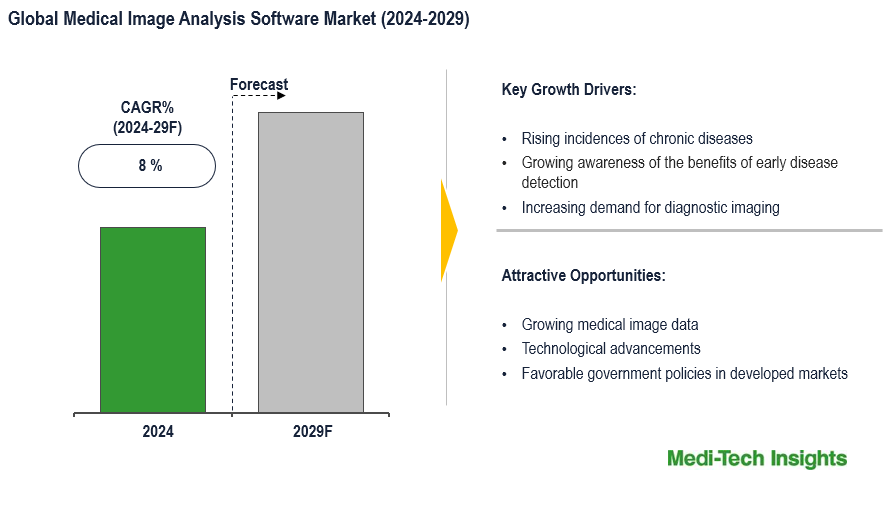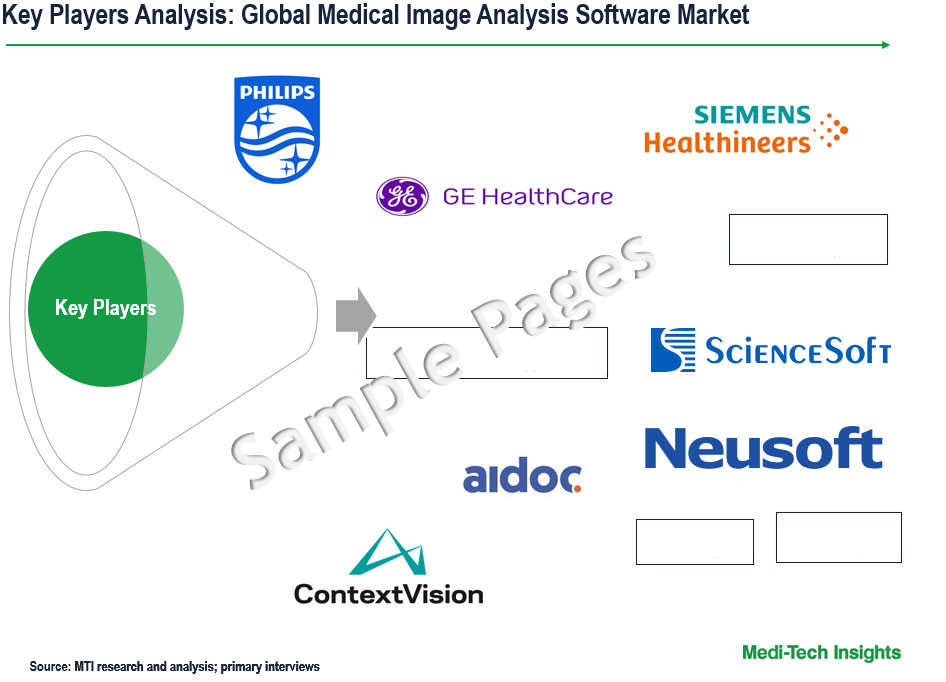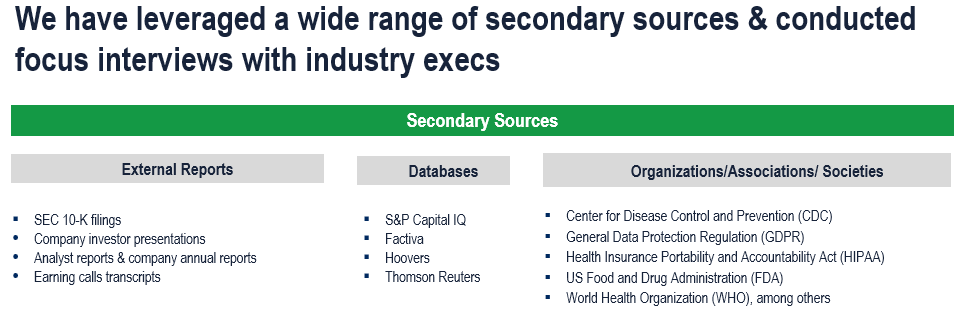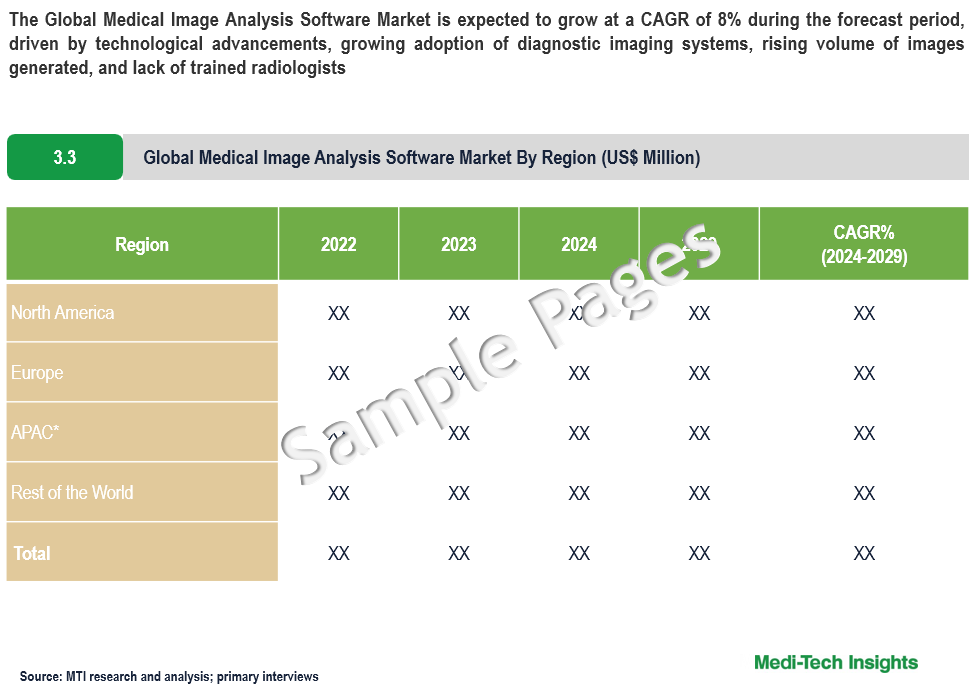
Global Medical Image Analysis Software Market Size, Share, Trends, Growth, and Future Outlook 2024 to 2029

The Global Medical Image Analysis Software Market is expected to grow at a CAGR of 8% during the forecast 2024 to 2029, driven by technological advancements, growing adoption of diagnostic imaging systems, rising volume of images generated, and lack of trained radiologists. To learn more about the research report, download a sample report.
Medical image analysis software is a specialized tool used to process, analyze, and interpret medical images from various modalities like MRI, CT, X-ray, and ultrasound. It assists healthcare professionals in diagnosing, monitoring, and treating medical conditions by providing advanced functions such as image enhancement, segmentation, registration, quantification, 3D reconstruction, and pattern recognition. Often incorporating artificial intelligence and machine learning, this software can detect and classify tissues or abnormalities, improving diagnostic accuracy. Additionally, it integrates with healthcare systems like PACS and EHR to streamline workflows and support clinical decision-making, ultimately enhancing the efficiency and effectiveness of medical imaging and contributing to better patient outcomes.
Growing Volume of Medical Images Coupled with Shortage of Radiologists
The healthcare industry is facing a significant challenge due to the growing volume of medical images coupled with a shortage of trained radiologists. Medical images account for approximately 90% of the data in healthcare, but more than 95% of this data remains unanalyzed or unused. The number of images generated globally is increasing annually, and this trend is expected to continue as more people gain access to better medical care. To address this issue, the adoption of medical image analysis software is on the rise, as it helps increase the speed and accuracy of analysis, thereby reducing report turnaround time. However, the effective use of this software can be hindered by flawed, incomplete, or poor-quality images. This poses a challenge in efficiently leveraging the full potential of medical image analysis software to address the growing demand for timely and accurate medical diagnoses.

To learn more about this report, download the PDF brochure
Technological Advancements in the Medical image analysis software market
Medical image analysis software has significantly advanced, incorporating multiple imaging modalities such as MRIs, CT scans, ultrasound, and nuclear medicine. These advancements have the potential to greatly reduce radiologist workload, though they are not yet capable of fully replacing radiologists. Companies in this field are continuously enhancing the analytic capabilities of their software, aiming to develop systems that can independently detect clinical anomalies in medical images. This evolution reflects a concerted effort to improve diagnostic accuracy and efficiency, paving the way for more autonomous and intelligent imaging solutions in the future.
Recent innovations include the integration of artificial intelligence and machine learning algorithms, which enhance the software's ability to recognize complex patterns and subtle changes in medical images. Additionally, cloud-based solutions are becoming more prevalent, offering scalable storage and powerful computational resources that enable real-time analysis and remote access to imaging data. These advancements not only facilitate more efficient workflows but also support collaborative efforts among medical professionals across different locations.
Furthermore, regulatory bodies are increasingly recognizing the importance of these technologies, leading to faster approval processes and broader adoption in clinical settings. As a result, the medical image analysis software market is experiencing rapid growth, driven by the need for more precise and timely diagnoses, particularly in fields such as oncology, cardiology, and neurology. The ongoing improvements in software capabilities are expected to continue transforming the landscape of medical imaging, ultimately enhancing patient care and outcomes. For instance,
- In November 2023, Philips announced the expansion of its enterprise imaging portfolio with the launch of HealthSuite Imaging, a next-generation, cloud-based PACS on AWS featuring AI-enabled clinical and operational workflows, designed to enhance radiologist and clinician capabilities, improve efficiency, and elevate patient care, as unveiled at RSNA23
- In February 2023, Methinks announced that it had received the CE mark for its medical imaging software, Methinks Stroke Suite, following a milestone year of development progress, enabling its commercialization in Europe and its use to assist in emergency settings for the benefit of acute stroke patients.
- In April 2022, CLAIRVO TECHNOLOGIES, Inc. obtained market authorization for VIDA Insights, an image analysis software developed by VIDA Diagnostics Inc. to assist in reading chest CT images, marking Clairvo's first product certified under the PMD Act and commenced its marketing and sales
- In Sep 2021, Israel-based Aidoc partnered with Subtle Medical to bring end-to-end AI solutions to medical imaging
Regional Trends: Medical image analysis software market
According to American College of Radiology, the diagnostic imaging industry has expanded over a decade due to the population being covered under Medicare, particularly for expensive techniques such as CT, MRI, and PET. North America dominates the medical image analysis software market attributed to presence of well-established healthcare facilities with advanced diagnostic imaging equipment, supportive healthcare IT infrastructure and government regulations, and presence of leading companies in this field in the US.

To learn more about this report, download the PDF brochure
Growth Opportunities in Oncology & Mammography Application Areas
The medical image analysis software market is characterized by its broad application across various medical fields, including oncology, cardiology, orthopaedics, dentistry, mammography, and neurology. Among these, cardiology holds a substantial share of the market, driven by the critical need for precise cardiac imaging and diagnostics. However, significant growth is anticipated in the adoption of this software in mammography and oncology. This surge is attributed to advancements in imaging technologies and increasing demand for early detection and treatment planning in breast cancer and other oncological conditions. As a result, these segments are expected to expand their market share considerably in the coming years, reflecting the evolving needs and technological progress in medical imaging.
Hospitals and Diagnostic Centers Leads the Adoption
The medical image analysis software market serves a diverse array of end-user segments, including hospitals, diagnostic centers, and research institutes. Hospitals account for the largest market share, driven by their extensive need for advanced imaging solutions to support patient diagnosis, treatment planning, and ongoing care. Diagnostic centers also represent a significant portion of the market, as they rely heavily on precise imaging software to enhance diagnostic accuracy and efficiency. Research institutes, while comprising a smaller segment, are crucial for the development and validation of new imaging techniques and technologies. These institutions contribute to the market by driving innovation and expanding the applications of medical image analysis software, underscoring their importance despite a relatively smaller market share compared to hospitals and diagnostic centers.
“Hospitals are the major end-users of medical image analysis software, followed by diagnostic centers. This is mainly attributed to huge installed base of diagnostic imaging systems, significant patient inflow and budget for installing such software to reduce physician/radiologist workload.” - VP, Sales & Marketing, Leading Supplier, US
Competitive Landscape: Medical Image Analysis Software Market
The global medical image analysis software market is fragmented. Some of the key players operating in this market are GE Healthcare, Philips Healthcare, Siemens Healthineers, AQUILAB, Agfa Healthcare, IBM, MIM Software Inc., Canon Medical Systems, Xinapse Systems, ContextVision, Quantib B.V., Mirada Medical Limited, Neusoft Medical Systems, INFINITT Healthcare, Oxagile, Esaote, Lunit, Aidoc, ChironX, Contextflow, 4Quant, Qure, Methinks, AnalyzeDirect and ScienceSoft among others.

Get a sample report for competitive landscape analysis
Organic and Inorganic Growth Strategies Adopted by Players to Establish Their Foothold in the Market
Players operating in this market are adopting both organic and inorganic growth strategies such as collaborations, acquisitions, and new product launches to garner market share. For instance,
- In May 2024, AGFA HealthCare announced that St. Vincent’s Private Hospital in Dublin, Ireland, has chosen to implement AGFA HealthCare’s Enterprise Imaging under a 5-year agreement. This includes solutions for Radiology and Breast Imaging, structured and precision reporting modules, XERO Universal Viewer, AGFA’s Scheduling solution, Business Intelligence, Patient and Clinician portal, and a Managed Services contract.
- In April 2024, GE HealthCare's MIM Software announced a collaboration with Elekta to enhance radiation therapy treatments and improve patient outcomes, building on their existing global commercial agreement to provide comprehensive imaging and treatment solutions for hospitals and cancer patients worldwide
- In February 2024, respiratory imaging technology company 4DMedical Limited announced an agreement with Blackford Analysis Inc. to distribute Imbio’s medical imaging AI solutions
- In January 2024, GE HealthCare announced an agreement to acquire MIM Software, a global provider of medical imaging analysis and AI solutions for various medical fields, aiming to leverage MIM's capabilities to enhance innovation and differentiate its solutions for patients and healthcare systems worldwide
- In December 2023, 4DMedical announced a binding agreement to acquire Imbio, aiming to revolutionize respiratory imaging and lung disease management by combining their groundbreaking lung imaging technologies with Imbio's quantitative and personalized imaging analysis for both acute and chronic diseases
- In November 2023, the European Innovation Council (EIC) Fund and Methinks AI announced a significant investment of €2.5 million in convertible loans from the EIC Fund, along with participation from existing investors and a new investor, to help Methinks AI prepare for its upcoming investment round
The market is expected to gain further momentum in the coming years due to technological advancements, rising R&D investments, new product launches, and aggressive organic and inorganic growth strategies followed by the players.
Medical Image Analysis Software Market Futures and Scope
| Report Scope | Details |
| Base Year Considered | 2023 |
| Historical Data | 2022 - 2023 |
| Forecast Period | 2024 - 2029 |
| CAGR (2024-2029) | 8% |
| Segment Scope | Product, Application, End User |
| Regional Scope |
|
| Key Companies Mapped | GE Healthcare, Philips Healthcare, Siemens Healthineers, AQUILAB, Agfa Healthcare, IBM, MIM Software Inc., Canon Medical Systems, Xinapse Systems, ContextVision, Quantib B.V., Mirada Medical Limited, Neusoft Medical Systems, INFINITT Healthcare, Oxagile, Esaote, Lunit, Aidoc, ChironX, Contextflow, 4Quant, Qure, Methinks, AnalyzeDirect and ScienceSoft among others |
| Report Highlights | Market Size & Forecast, Growth Drivers & Restraints, Trends, Competitive Analysis |
Key Strategic Questions Addressed
-
What is the market size & forecast for the Global Medical Image Analysis Software Market?
-
What are the historical, present, and forecasted market shares and growth rates of various segments and sub-segments of the Global Medical Image Analysis Software Market?
-
How has COVID-19 impacted the Global Medical Image Analysis Software Market?
-
What are the major growth drivers, restraints/challenges impacting the market?
-
What are the opportunities prevailing in the market?
-
What is the investment landscape?
-
Which region has the highest share in the global market? Which region is expected to witness the highest growth rate in the next 5 years?
-
Who are the major players operating in the market? What is the competitive positioning of key players?
-
Who are the new players entering the market?
-
What are the key strategies adopted by players?
- Research Methodology
- Secondary Research
- Primary Research
- Market Estimation
- Market Forecasting
- Executive Summary
- Market Overview
-
- Market Dynamics
- Drivers
- Restraints
- Key Market Trends
- Industry Speaks
- Market Dynamics
- Key Revenue Pockets
- Global Medical Image Analysis Software Market - Size & Forecast (2021-2028), By Imaging Type
- 2D – Imaging
- 3D – Imaging
- 4D – Imaging
- Global Medical Image Analysis Software Market - Size & Forecast (2021-2028), By Application Type
- Cardiology
- Oncology
- Mammography
- Orthopaedics
- Neurology
- Others
- Global Medical Image Analysis Software Market - Size & Forecast (2021-2028), By End User Type
- Hospitals
- Diagnostic Centers
- Other End Users
- Global Medical Image Analysis Software Market - Size & Forecast (2021-2028), By Region
- North America (U.S. & Canada)
- Europe (UK, Germany, France, Italy, Spain, Rest of Europe)
- Asia Pacific (China, India, Japan, Rest of Asia Pacific)
- Rest of the World (Latin America, Middle East & Africa)
- Competitive Landscape
- Key Players and their Competitive Positioning
- Competitive Positioning of Key Players (2022)
- Offerings Assessment, By Player
- Key Strategies Assessment, By Player (2021-2023)
- New Product & Service Launches
- Partnerships, Agreements, & Collaborations
- Mergers & Acquisitions
- Geographic Expansion
- Key Players and their Competitive Positioning
- Key Companies Scanned (Indicative List)
- GE Healthcare
- Philips Healthcare
- Siemens Healthineers
- AQUILAB
- Agfa Healthcare
- IBM
- MIM Software Inc.
- Canon Medical Systems
- Xinapse Systems
- ContextVision
- Quantib B.V.
- Neusoft Medical Systems
- INFINITT Healthcare
- Esaote
- Aidoc
- Contextflow
- Qure
- ScienceSoft
- Other Prominent Players
The study has been compiled based on extensive primary and secondary research.
Secondary Research (Indicative List)

Primary Research
To validate research findings (market size & forecasts, market segmentation, market dynamics, competitive landscape, key industry trends, etc.), extensive primary interviews were conducted with both supply and demand-side stakeholders.
Supply Side Stakeholders:
- Senior Management Level: CEOs, Presidents, Vice-Presidents, Directors, Chief Technology Officers, Chief Commercial Officers
- Mid-Management Level: Product Managers, Sales Managers, Brand Managers, Business Development Managers, Consultants
Demand Side Stakeholders:
- Stakeholders in Hospitals, Diagnostic Centers and Other End Users
Breakdown of Primary Interviews

Market Size Estimation
Both ‘Top-Down and Bottom-Up Approaches’ were used to derive market size estimates and forecasts.
Data Triangulation
Research findings derived through secondary sources & internal analysis were validated with Primary Interviews, Internal Knowledge Repository, and Company Sales Data.


